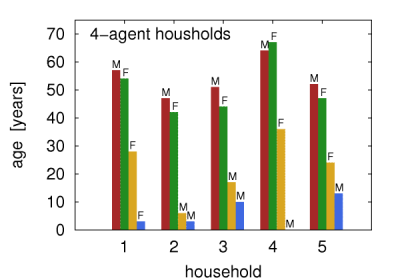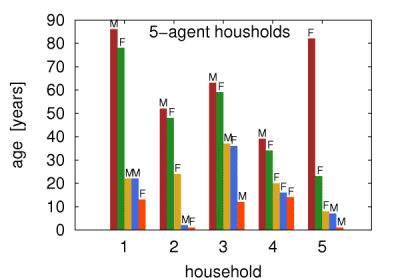Difference between revisions of "Virtual society:results"
(→Basic Virtual Society - population and location of households) |
(→Basic Virtual Society - population and location of households) |
||
| Line 11: | Line 11: | ||
The obtained population of households reproduced the actual statistics obtained from the NCB. In particular, the number of inhabitants per km2 differs by less than 20 individuals from the values obtained from LandScan, and the size distribution of the households, the distribution of the age difference in couples/parents, the distribution of children number in households, and the distribution of the parents' age are all also well reproduced. Example 2,3,4, and 5-agent households are presented in Figures 1a-d. | The obtained population of households reproduced the actual statistics obtained from the NCB. In particular, the number of inhabitants per km2 differs by less than 20 individuals from the values obtained from LandScan, and the size distribution of the households, the distribution of the age difference in couples/parents, the distribution of children number in households, and the distribution of the parents' age are all also well reproduced. Example 2,3,4, and 5-agent households are presented in Figures 1a-d. | ||
| − | + | [[Image:households2_color.png |frame|left| '''Fig.1a''':Example of virtual households created in this work. M and F symbols correspond to male and female agents, respectively]] | |
| − | Image:households2_color.png | Fig.1a | + | [[Image:households3_color.png |frame|right| '''Fig.1b''' ]] |
| − | Image:households3_color.png | Fig.1b | + | [[Image:households4_color.png |frame|left| '''Fig.1c''' ]] |
| − | Image:households4_color.png | Fig.1c | + | [[Image:households5_color.png |frame|right|'''Fig.1d''']] |
| − | Image:households5_color.png | Fig.1d | ||
| − | |||
== Distance to institution statistics == | == Distance to institution statistics == | ||
Revision as of 17:31, 31 October 2008
| Virtual society | Virus spread | Literature | Version | |
|---|---|
| Data | Model | Results |
We are reporting here some selected results describing properties of our Basic Virtual Society model. In such a system various ranges of quantitative analysis can be considered. However, we focus here on the features essential for ongoing epidemiological and transportation studies, as well as on the planned future investigations. Since the methods used for recreation of a given social nodes, e.g. schools and workplaces are in principle similar, we limit the description here only to one selected type of network structure.
Basic Virtual Society - population and location of households
The obtained population of households reproduced the actual statistics obtained from the NCB. In particular, the number of inhabitants per km2 differs by less than 20 individuals from the values obtained from LandScan, and the size distribution of the households, the distribution of the age difference in couples/parents, the distribution of children number in households, and the distribution of the parents' age are all also well reproduced. Example 2,3,4, and 5-agent households are presented in Figures 1a-d.



